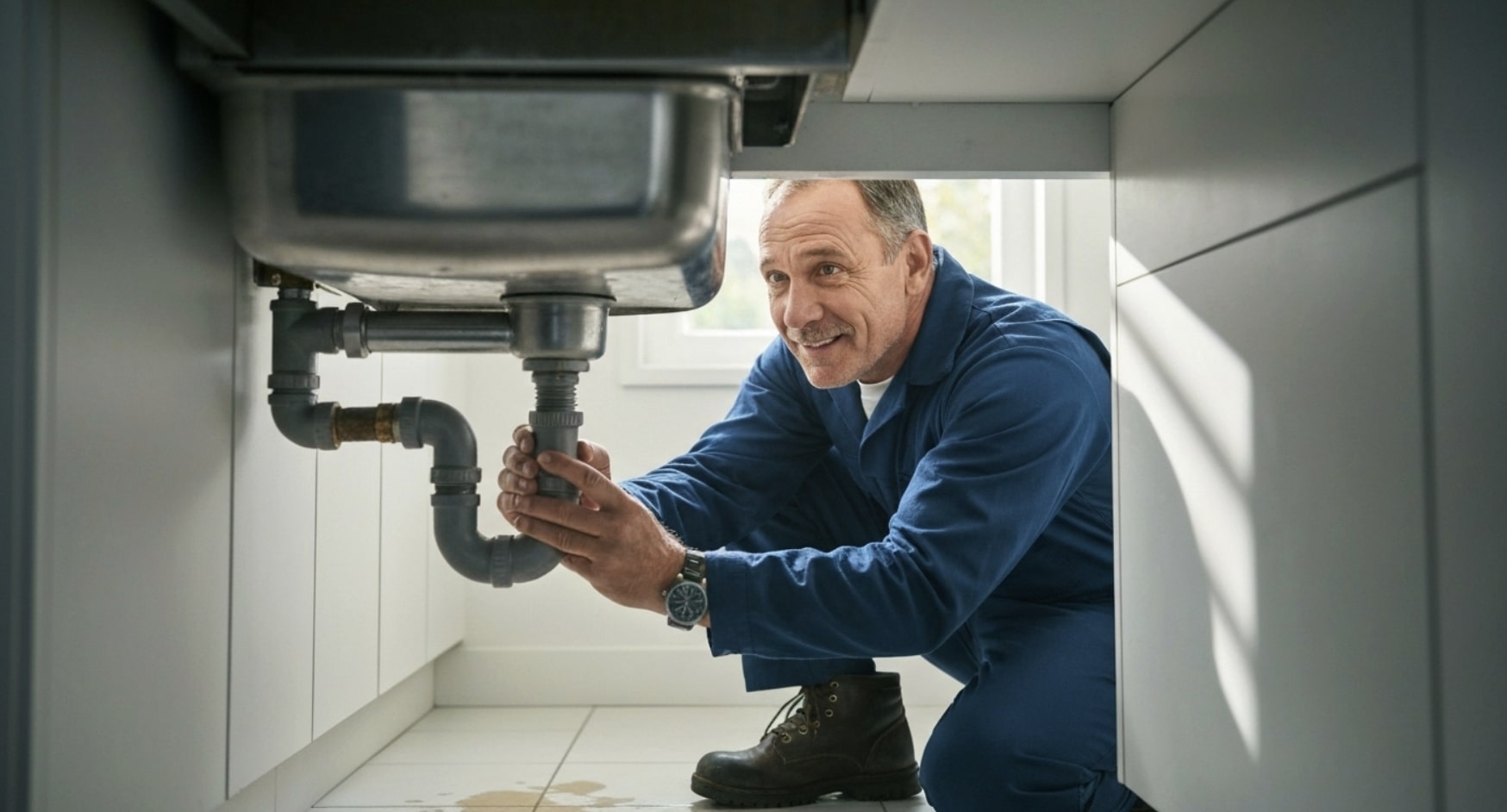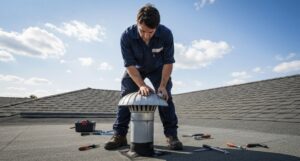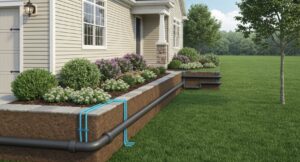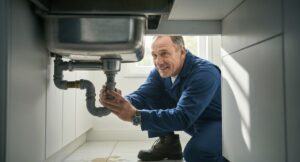That tiny drip-drip-drip from a faucet might seem like a minor annoyance, but it could be a warning sign of bigger trouble. Small leaks in your home’s plumbing system are often ignored, yet they can lead to widespread water damage, rot, and expensive repairs. The good news? You have the power to stop these issues before they start. By learning to spot the early signs and taking proactive steps, you can protect your home and your wallet from the costly consequences of unchecked plumbing leaks.
Why Small Leaks Matter
You might be tempted to put a bucket under a small leak and forget about it, but this approach can lead to disaster. These minor drips are often symptoms of a bigger problem within your plumbing. For example, a homeowner once noticed their toilet rocking slightly for years but delayed the repair. Eventually, the ceiling below collapsed because the toilet’s wax ring had been leaking with every flush, completely rotting the subfloor.
This story is a powerful reminder that a leaking pipe is never just a “small” problem. The continuous exposure to moisture can delaminate flooring, cause paint to peel, and weaken structural components of your home. What begins as a tiny issue can escalate into a massive and expensive restoration project that affects your entire home.
Ultimately, addressing small leaks immediately is one of the most cost-effective maintenance tasks you can perform. It prevents water damage, protects your property’s value, and ensures your home remains a safe and healthy environment. Don’t wait for a catastrophe; treat every leak with the seriousness it deserves.
Typical Areas Prone to Leaks in the Home
Your home’s plumbing is complex, but leaks usually occur in a few key areas. Bathrooms and kitchens are most at risk due to their many fixtures and water lines. Leaks often develop near frequently used fixtures as seals wear out and connections loosen.
Focus your inspections on these common trouble spots:
- Toilets: Wax ring, supply line, and tank components
- Sinks: Drain, supply lines, and sink rim
- Tubs/Showers: Drain seals, grout or caulk, and splash zones
- Water Heaters: Pressure relief valve, drain valve, and supply line connections
Regularly checking these areas can help prevent minor leaks from becoming major problems.
Common Causes of Small Plumbing Leaks
Have you ever wondered why that annoying drip started in the first place? Small leaks don’t just happen; they are usually the result of specific failures in your plumbing system. Identifying the source of the leak is key to applying the right fix and preventing it from happening again. A leaky pipe is often caused by aging components or installation issues.
Understanding these common points of failure will help you diagnose problems more effectively.
1. Faulty Pipe Connections
Plumbing leaks typically occur at joints and connections due to vibrations, water pressure, or temperature changes that loosen fittings. Loose compression nuts on supply lines and corrosion in older pipes are common causes. The EPA, or Environmental Protection Agency, recommends maintaining fixtures and inspecting connection points for moisture or discoloration, which indicate leaks. Tightening nuts or replacing corroded sections can prevent major issues.
2. Worn-Out Seals and Washers
Nearly every plumbing connection contains a seal, gasket, or washer to create a watertight barrier. Made from rubber or flexible materials, these components can harden, crack, and lose effectiveness over time—often causing leaks in faucets, showerheads, tub drains, and toilets. For example, a constant drip is usually due to a worn washer, while a faulty tub gasket or toilet wax ring can lead to water damage. When fixing leaks, always check seals first; replacing them is often an easy and inexpensive solution that prevents bigger problems.
Early Signs of Water Leaks in Your Plumbing System
The best way to prevent major water damage is to catch leaks early. Your home often gives you subtle clues that something is wrong with the plumbing system long before a pipe bursts. Learning to recognize these early signs of a leak can save you a significant amount of money and stress. Let’s look at some of the most common red flags.
1. Unexplained Increases in Water Bills
A sudden spike in your water bill, without a change in usage, is a reliable sign of a leak. If your bill jumps by over $100, especially with no visible water, hidden leaks may be the cause. Compare current bills to previous months and last year’s statements—a consistent increase signals a persistent leak. Reviewing your bills is an easy way to detect plumbing issues without any tools.
2. Visible Water Stains and Musty Odors
Your nose and eyes can help detect water damage. A persistent musty odor, especially in bathrooms, laundry rooms, or basements, often signals mold or mildew from hidden leaks. If the smell remains after cleaning, suspect a water issue. Visually, watch for yellowish or brown stains on walls and ceilings, peeling paint, or bubbling wallpaper—these indicate moisture behind surfaces. Spotting these signs early helps prevent further damage and costly repairs.
Beginner’s Guide: Preventing Water Damage from Small Leaks
Now that you know the risks and the signs, it’s time to get proactive. Preventing water damage from small leaks doesn’t always require a professional. With a little knowledge and a few basic tools, you can perform routine checks and minor repairs yourself. This guide is designed for any homeowner who wants to protect their investment.
Following a simple, step-by-step process can help you systematically inspect your home, identify potential problems, and address them before they escalate. Let’s get you started on the path to a leak-free home.
What You’ll Need to Get Started
You don’t need a plumber’s full toolkit to fix common small leaks. A basic plumbing kit prepares you for routine checks and simple repairs, and most tools are affordable at any home improvement store. Having your materials ready makes inspections quicker and lets you fix minor issues immediately.
Essential DIY leak prevention tools:
- Flashlight
- Adjustable wrench
- Slip-joint pliers
- 4-in-1 screwdriver
- Utility knife
- Caulk gun with silicone or tub/tile caulk
- Assorted gaskets and seals
Step 1: Inspect Exposed Pipes and Fixtures Regularly
Start with a simple visual inspection. Regularly check exposed pipes, especially in leak-prone areas. Use a flashlight to inspect under kitchen and bathroom sinks for moisture, drips, or corrosion on supply lines and drain pipes. Check behind toilets and examine washing machine hoses for bulges, cracks, or rusted fittings. Run your hand along the bottom of pipes to feel for hidden leaks. Scanning these areas every few months can help you catch leaks early and prevent major damage.
Step 2: Check for Mold, Damp Spots, and Peeling Paint
Your home’s surfaces can reveal plumbing issues. During inspections, check not just pipes but surrounding walls, ceilings, and floors for signs of leaks like dark patches or discoloration. In bathrooms, look for mold that returns quickly after cleaning—this may mean water is seeping behind tiles. Watch for peeling paint or bubbling wallpaper, which also signal moisture. Examine ceilings below bathrooms and laundry rooms; yellowish rings often indicate slow leaks from above. Spotting these early helps you address problems before serious damage occurs.
Step 3: Test Faucets and Toilets for Silent Leaks
Some of the most wasteful leaks are silent, often coming from toilets and faucets. To check for a toilet leak, add food coloring to the tank and wait 15–20 minutes without flushing. If colored water appears in the bowl, you have a leak—usually caused by a faulty flapper. This is an easy, inexpensive fix that can save water and money.
For faucets, especially under sinks, wipe connections dry and dab with tissue or paper towel. Even tiny leaks will show as wet spots on the tissue, revealing slow leaks you might miss otherwise.
Step 4: Monitor Water Meter for Fluctuations
Your water meter is the best tool for detecting hidden leaks on your property, as it tracks all water entering your home. To test for leaks, first turn off all water-using appliances and faucets. Locate your meter—usually near the curb or in your basement—and check its leak indicator (a small dial or triangle). If it’s moving, you have a fast leak. If not, note the reading, wait two hours without using water, then check again. Any change indicates a slow, hidden leak. This simple test reveals leaks even if there are no visible signs.
Step 5: Repair Minor Leaks with Proper Materials
Once you find the leak, repair it promptly. Small leaks can often be fixed yourself. For a leaking pipe joint under a sink, first gently tighten the compression nut with an adjustable wrench—don’t overtighten. If that doesn’t work, turn off the water supply, disassemble the joint, and replace the washer or gasket. Add Teflon joint compound to threads for extra protection before reassembling.
For leaks around sink rims or shower frames, remove old caulk and apply fresh caulk to a clean, dry surface for a waterproof seal. These simple fixes can permanently stop many common small leaks.
How to Identify Hidden Plumbing Leaks
The most frustrating leaks are the ones you can’t see. Hidden plumbing leaks behind walls, under floors, or in your yard can cause serious damage before they’re noticed. While high water bills or meter tests may alert you to a leak, finding the exact source is challenging. Fortunately, with patience and careful observation, a few techniques can help you locate the problem without tearing down walls.
Using Water Meter Readings for Detection
Start with a water meter test to confirm a hidden plumbing leak. If the meter indicates a leak, close your home’s main shutoff valve (usually where the water line enters the house). Check the meter again:
- If it stops moving, the leak is inside your home.
- If it keeps moving, the leak is in the underground pipe between the meter and your house.
This process quickly narrows down where to search. Most leaks occur near fixtures like tubs, sinks, or toilets. Knowing if the problem is inside or outside helps you or a plumber focus your efforts.
Steps:
- Turn off all water inside and outside.
- Check the water meter—if it’s moving, you have a leak.
- Close the main shutoff valve.
- Check the meter again—if it stopped, the leak is inside; if still moving, it’s outside.
Listening for Running Water Sounds Behind Walls
When your house is quiet, use your ears to detect hidden plumbing leaks. Press your ear against suspect walls and listen for hissing, dripping, or running water—especially near bathrooms and kitchens. Do this at night or when background noise is minimal. The sound is usually loudest near the leak. While not foolproof, this method can help you narrow down the location and avoid unnecessary wall damage. Professional plumbers use advanced listening devices, but your ears are a good starting point.
Your Lifeline for Leaks, Clogs, and More—Target Plumbers Deliver
While many small leaks can be a DIY fix, some problems are best left to the professionals. If you’ve tried the tests and still can’t find the source, or if the repair is beyond your comfort level, it’s time to call for backup. At Target Plumbers, we have the experience and advanced tools to accurately locate and repair any issue in your plumbing system, from a tricky leaky pipe to hidden underground leaks. Our team is trained to solve your plumbing problems efficiently, saving you time and preventing further damage.
Don’t let leaks, clogs, or other plumbing mysteries cause you stress. We are your reliable partner for maintaining a healthy and efficient home. Whether you need an emergency repair or a routine inspection, our experts are here to deliver fast, friendly, and effective service. Trust Target Plumbers to be your lifeline, ensuring your plumbing system is in top condition and your home is protected from water damage.
Conclusion
Preventing water damage from small plumbing leaks is crucial for maintaining a safe and healthy home. By regularly inspecting your plumbing system and being vigilant about early signs of leaks, you can save yourself from costly repairs and extensive damage. Remember, even seemingly minor issues can escalate if left unchecked. Equip yourself with the knowledge and tools necessary for effective leak prevention, ensuring that your home remains a secure haven.
This topic expands on the tips found in our blog, Plumbing Maintenance Tips That Every Homeowner Should Know, which covers leak prevention strategies.
Frequently Asked Questions
How can I quickly detect a hidden plumbing leak in my house?
To quickly detect hidden plumbing leaks, use your water meter. Turn off all water, then check the meter’s leak indicator. If it’s moving, you have a leak. If not, record the reading, wait two hours without using water, and check again. A change in the reading confirms a hidden water leak in your plumbing system.
What are the early signs that I have a water leak in my plumbing system?
Early signs of a leak include an unexplained increase in your water bill, visible water stains on walls or ceilings, musty odors from mold growth, peeling paint, and the sound of running water when all faucets are off. Spotting these signs of water damage early can prevent major issues with your plumbing system.
How do I identify the source of a plumbing leak when I can’t see visible water?
To find the source of the leak without visible water, use the water meter test to confirm if the leak is inside or outside. Then, listen carefully for hissing or dripping sounds behind walls. These methods can help you narrow down the location of the leaky pipe causing the hidden water leak.
How do plumbers detect leaks in pipes?
Plumbers use various methods to detect leaks in pipes, including visual inspections, acoustic listening devices, and thermal imaging cameras. These tools help identify the location and severity of plumbing leaks without invasive procedures, ensuring efficient repairs and minimizing water damage. Regular maintenance can also help prevent future leaks.






